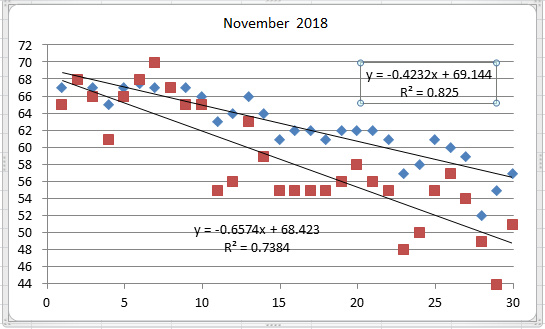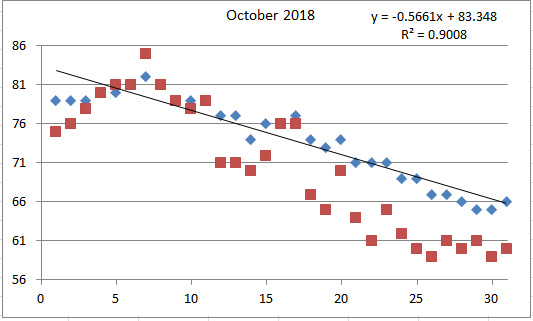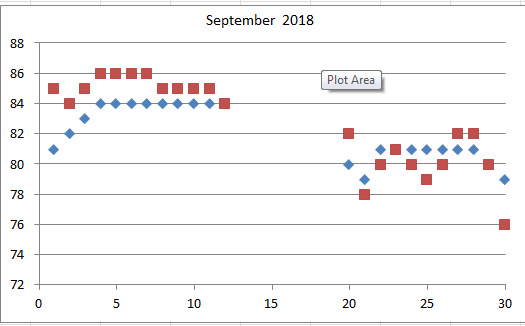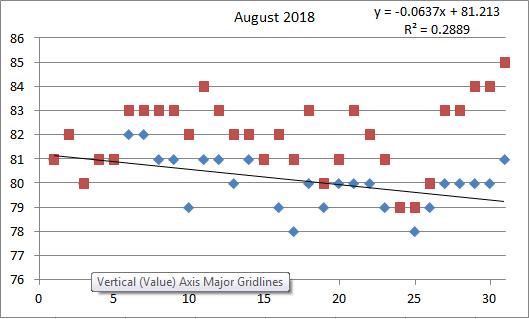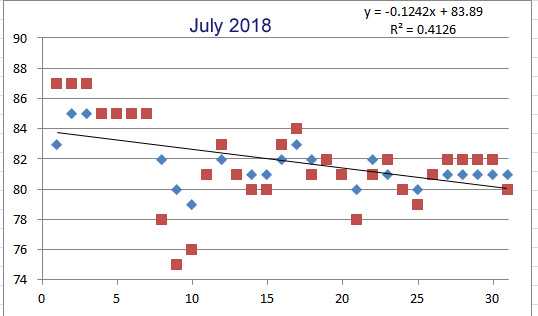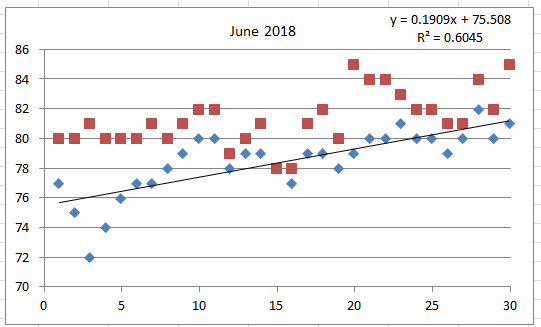Coastal Daybreak Radio Show WTKF 107.1, FM 1240 AM, Host Ben Ball. Jacob Krause, Guest 11/5/18
I have a return guest Jacob Krause, NC State graduate student working on his Ph.D. We’ve had a number of shows that we talked about speckled trout with Tim Ellis and now we have talked for several years now with Jacob about weakfish/gray trout. Good morning Jacob, so how are things going?
Jacob Krause: We’re finally at the tail end of the project and we have a lot of results all at once here.
Dr. Bogus: Well having been there…done that, I know the feeling, but unlike you I ended up having a job at another location. I had to finish my thesis writing on Long Island rather than Washington, DC so that took an extra year to finish it up. Why don’t you describe what the project was Jacob, and the approach to deal with the understanding of where the weakfish are. We know that weakfish…we’re down to a one fish 12-inch harvest per day limit, and there is a reason for that. There’s been a big falloff…so what’s the project?
Jacob Krause: So, a little bit of background. The weakfish have been in decline especially since the mid-2000s and the reason for that has been speculated to be predation, not enough spawners, just a multitude of hypotheses but there hasn’t been a really definitive reason for why that is the case. With the decline, as Dr. Bogus pointed out there’s been more restrictions in the take on these fish and right now we are down to one fish over 12-inches. My work is really looking at understanding why the decline in weakfish has happened over the years. We’ve used multiple approaches in order to get at that, what we call mortality or death of these fish that seems to be driving the population downwards. And one approach that we’ve done is to release telemetered fish. Telemetered fish is fish that we track throughout estuarine systems. To date we’ve released 241-fish. Some of those were in Delaware Bay, the majority of them were here in the Bogue Sound vicinity and we’ve also released some fish in the New River.
Ben Ball: They’re tags that you can track when you say telemetered.
Jacob Krause: Exactly, these fish, you actually put receivers that detect these fish within the sounds and there is a large array, a placement of receivers, up and down the East Coast.
Dr. Bogus: Some of these receivers are obviously used for a variety of studies, so you can buy into that right?
Jacob Krause: Exactly, so there is currently ongoing studies off the coast for sand tigers, cobia, sturgeon, just a plethora, so if these fish go anywhere within about 400- to 600-yards of these receivers they’ll get picked up and we will know that that individual fish mover within that specific vicinity.
Dr. Bogus: You have the telemetry fish, you also did the conventional tagging of quite a few fish with the help from some of our friends.
Jacob Krause: Exactly, so I had a lot of help from people here in the area especially with finding out where and when to catch these fish. And all the tags we out were $100 tags, very high reward.
Dr. Bogus: You wanted them (the tags) to come back.
Jacob Krause: We wanted them to come back! And most of those were double tagged fish. Using these two approaches it really came down to that weakfish survival was very low. What we found with the telemetered is that these fish go and overwinter on the Continental Shelf and they should return to the estuaries every spring as they are natal spawners. So much like salmon that come back to the same areas every year, or the same area from which they were spawned so too should weakfish. And what we found is that out of 241 fish, only one fish came back the following spring after that overwintering migration.
Dr. Bogus: Where was that fish located? Where did you find him?
Jacob Krause: That one was released here near the port (Morehead City) and it came back and was detected the following spring down by Emerald Isle.
Dr. Bogus: So very close to where it started from.
Jacob Krause: Exactly! But it did make the appearance that it had left the system in the winter and that it had come back in the following spring.
Dr. Bogus: Is there something that you may conclude from the time frame there, like when you can within 100-days 92% of these came back. Is that significant…the time frame?
Jacob Krause: So the time frame is definitely significant because it’s giving us an idea when this mortality, or when the death is happening for these fish. So for the conventional tagged fish we had about 135 returns out of 3600 tagged fish that we put out. And what we found with that is that 92% came back within 100-days and when we think about that overwintering migration only 5-tags came back after an overwintering migration. So that really points to that these fish are leaving in the winter to deal with the cold water by going off onto the Continental Shelf but they are not coming back the following spring. So both of these really show that we are putting out a lot of tags and very minimal amounts are coming back and it seems to be happening that the mortality is happening during the wintertime.
Dr. Bogus: These fish have…they’re cousins, not kissing cousins, the speckled trout…obviously the biology of these two fish are quite different where they overwinter and probably where even they spawn.
Jacob Krause: Yes, so there is some overlap within the sound but even that I would call they’re different habitats within the sound. So for instance, weakfish here in Bogue Sound you tend to find them in the deeper holes like the port and around the bridges as the speckled trout often times those are found the rock jetties, more the grass beds in the shallower areas and they both have different life history strategies where speckled trout move inshore and overwinter in the creeks and weakfish take the opposite approach and they more offshore to deal with the cold winters.
Dr. Bogus: I’ve noticed that…I can tell when they start to return, I start to catch and actually sometimes mixed in with the speckled trout in like April. Is that usually a time when they come back? And most of the fish that I catch at that time are egg-baring females.
Jacob Krause: Exactly, so around here, I think the earliest we ever caught them was April-first and about two to three weeks later you could definitely tell, as you said, that they were very ripe, the females. And they were coming in to spawn especially near structure around the inlets and they can spawn multiple times, and that usually occurs from April until July, so that can really put out a lot of larvae.
Ben Ball: We used to go fishing for gray trout or weakfish in the Haystacks in around Thanksgiving, that used to be a big time.
Jacob Krause: There is still some of that direction but it’s very minimal. I’ll say that you’re going to catch a speck more times over than a weakfish. It really seems that there are pockets and they really like structure around the port, the bridges and they are very tidal dependent, usually right around the tail ends of slack tide especially high tide.
Dr. Bogus: Your research has to do with dwindling numbers of weakfish/gray trout, so the first question is what are some possible mechanisms for fish mortality that may be responsible?
Jacob Krause: There are two ways from our perspective, that it can be through fishing mortality or natural mortality. Fishing mortality as we’ve said before, there’s been a lot of restrictions and that does not seem to be the cause for the decline in weakfish from at least the early 2000s onwards. And in conjunction there’s natural mortality which are things such as predation, climatic events, disease all contribution and the hypothesis with the most support at this point seems to be predation. But we didn’t have an idea of what those predators were and how much of the weakfish population they could actually consume.
Dr. Bogus: Okay, so then the BIG question is what predators are out there that may or may not consume the weakfish and how do you figure that out? Who is eating our fish before we do?
Jacob Krause: So we did a large review of literature with diet studies and what we found is that striped bass, as a finfish predator definitely consumed weakfish during that winter time period. We also saw that bluefish, summer flounder and spiny dogfish all consumed weakfish, but the most surprising was that bottlenose dolphin also consume weakfish even at higher rates than these finfish predators and to put it into perspective 50% of the diet of a bottlenose dolphin during the winter consists of weakfish.
Dr. Bogus: …and how do we know that?
Jacob Krause: So I worked with collaborators at NOAA Lab and we looked at the diets of stranded bottlenose dolphins so we can see the stomach contents of those dolphins that washed up and we can estimate their consumption of different prey items like weakfish based on their stomach contents.
Dr. Bogus: What other things do the dolphin eat, were there other top snacks?
Jacob Krause: Yes there were top snacks and all fell out to be sciaenids which are the fish that make sounds, so 75% of the diet consisted of weakfish, spot and croaker.
Ben Ball: I noticed on your very colorful chart that for 2013 and 2014 or so looks like it dropped off for the bottlenose dolphin, any speculation there?
Jacob Krause: Yes, so when we estimated the total consumption for the different predators specific for the bottlenose dolphins we had to take into account that there has been two time periods between 1982 and 2014 where there was a large die-off within the bottlenose dolphin population and those were both due to morbillivirus. And we know that based on the increase in the number of strandings two different time periods, the first being 1988 and the second between 2013 and 2015.
Ben Ball: Would a decrease in the major predator like that also subsequently lead to an increase in the weakfish?
Jacob Krause: Yes I would say but our data ends in 2014 so we haven’t seen the product. I will say anecdotally and as we were putting out fish in and 2016 it seems that there were more weakfish and they were of greater size then at the beginning when I started this project in 2014. So there may be some evidence but it’s an ongoing experiment that we will see in future years if the weakfish start to rebound and that there is some good support for this hypothesis.
Ben Ball: But then again the food chain has played a huge roll. So if the dolphin come back, we may see the weakfish decline.
Jacob Krause: Exactly, and the other point to bring out with this is that there are other predators, it’s not just bottlenose dolphins. Striped bass have made a resurgence in the last 15 to 20-years bluefish seem to be coming back according to the stock assessments, spiny dogfish are again almost at all time level highs and summer flounder have been rebuilt. So when we have multiple fish species that are being managed for as many as we can for maximum sustainable yield it might be at the detriment of other fish species.
Dr. Bogus: Is it (predation) happening while over wintering at the continental shelf or in transit between the two, because the striped bass aren’t really a deep ocean fish. The flounder go out and spawn in the winter time, they are out off there and I don’t know what the life cycle of the dolphin are, do they spend a lot of time that far offshore?
Jacob Krause: So, when we think about weakfish going offshore in the wintertime it still remains somewhat of a mystery how far they go out, but it seems it would be within 10 to 15-miles of the shore maybe more depending on the typography of the shelf in that area. And what we find for instance with bottlenose dolphin is that there’s a population that lives between the Virginia boarder and New Jersey during the summer and they come down to North Carolina to overwinter off the nearshore shelf and so weakfish is in that same range and they follow that same movement.
Dr. Bogus: Is there any way Jacob of trying to fold in the mortality of the newly spawned fish that get caught in nets and things of that sort? Or is that really a number that we can’t get to?
Jacob Krause: It’s a difficult number to get at but there are from a fisheries gear perspective and what management does there are different indices that look at the number of fish that are spawned and so we can look at the number of larval fish and get an estimate on how many are there for instance in the summer, we would call “age zeros” and then the following spring we would use other gears maybe fisheries independent gill net survey or trawl surveys and see how many of those survived to the following year.
Dr. Bogus: How do you see this project going? You obviously are moving on, you’re writing things up and getting into cobia I hear, and where do you see this project going? Is there another step to this in either trying to manage of deal with the weakfish situation?
Jacob Krause: At this point I think the biggest thing is giving the information of what is the most likely reason for the weakfish decline in the population and from there managers and can incorporate that into the stock assessments and really use that information put some management strategies that may help these weakfish come back. It is difficult when there are a lot of other predators that are important to the fishery so sometimes maybe Mother Nature in the form of natural cycles within for instance bottlenose dolphin and striped bass may cause enough weakfish to survive the younger age classes to make it to harvestable size.
Dr. Bogus: It’s interesting when we’re talking to Tim Ellis with the speckled trout, and you now with the weakfish…it seems like in both cases the numbers of fish…the death of the are mostly natural causes. That seems to be the bottom line of both of these studies, is that correct?
Jacob Krause: Yes, natural mortality is really what shapes the dynamics or fluctuation within these populations and that makes it very difficult from a management perspective because managers can regulate harvest but you can’t tell a bottlenose dolphin not to eat a weakfish!
Ben Ball: Dr. Bogus you were talking about troutsicles for the speckled trout does that similarly affect the weakfish at all?
Jacob Krause: No, they should not be inshore in that amount where they would have the massive die-offs from the cold.
Dr. Bogus: They have taken another strategy than the speckled trout…
Jacob Krause: Which has its own costs and benefits as we have seen from the data here.
Dr. Bogus: Apparently so! Do you know what the major predator for the speckled trout are?
Jacob Krause: I have not looked at that so I’m not sure, but probably with what Tim Ellis has found it was COLD honestly is really the shaper of that! But anything, I would think bluefish, or anything that would interact within certain season, bluefish and other species like that.
Dr. Bogus: The number of the 1% survival from offshore to inshore plus or minus…
Jacob Krause: There is uncertainty in there but it shows that the magnitude of how many are not coming back.

